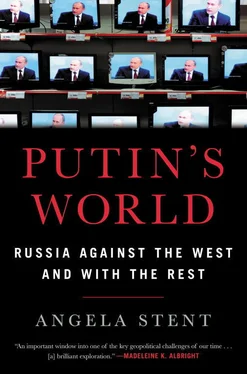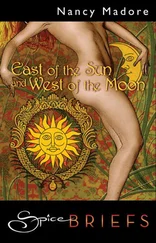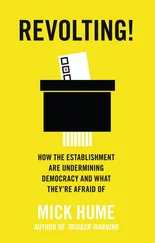The United States’ April 2018 sanctions against twenty-four businessmen and officials close to Putin and twelve businesses have adversely affected the billionaires’ domestic and international holdings. But the sanctions will, if anything, make them more dependent on the Kremlin’s largesse, and their companies are more likely to be bailed out by the Kremlin and de facto nationalized. Western sanctions may impose penalties, but they also strengthen Putin’s ability to increase state control over the economy.
Demographics are another major challenge. Despite a mini baby boom in recent years, the Russian population is declining, and life expectancy lags behind that of most industrialized countries. The figures for mortality among young men aged eighteen to thirty are particularly striking: they resemble those of sub-Saharan Africa rather than those of advanced industrial countries. This has significant implications for the future workforce and for military recruitment. However, while the Slavic birthrate is falling, Russia’s Muslim population continues to enjoy high birthrates and by 2020 Muslims will constitute one-fifth of the population of the Russian Federation, potentially challenging the tenuous ethnic peace that Putin has promoted. 6Many of the best and brightest young people have emigrated, and the brain drain shows no signs of abating. Moreover, a combination of neglect and systemic corruption has left Russia with a decaying physical infrastructure that requires concerted attention. The question is whether Putin will continue to replicate the pattern of the late Brezhnev era: domestic stagnation because reform is considered too destabilizing politically, combined with foreign policy activism that appeals to the population’s patriotism, and renewed nationalism that antagonizes the West.
A key question for the future is succession. According to the Russian constitution, this is Putin’s last term in office, and he is obliged to step down in 2024, by which time he will have been in power for one year less than was Stalin. Historically, there are several models for succession in a millennium of Russian history. The most common succession mechanism in the tsarist and Soviet times was death by natural causes. There were also several instances of death by unnatural causes, when tsars were assassinated. Rulers have also been overthrown in palace coups, in both the tsarist and Soviet times, when Khrushchev was ousted by his erstwhile comrades. Rulers have been overthrown by popular revolutions too, as in 1917. In the post-Soviet era, there have been only two managed transitions: when Boris Yeltsin chose Putin to succeed him and when Putin picked Medvedev—in the latter case, only to switch places with him four years later and return to the Kremlin.
Will Putin choose his successor again? Some Russians question whether he will indeed step down, arguing that he may remain in the Kremlin for the rest of his life. Immediately after his 2018 election, Margarita Simonyan, editor-in-chief of the state-controlled television station RT, tweeted enthusiastically to the West: “Earlier he was simply our president and it was possible to replace him. And now he is our leader. We won’t let you change him.” 7She used the word Vozhd (leader) to refer to Putin—echoing the term used to describe Stalin. Will Putin take his cue from Xi Jinping and Nursultan Nazarbayev and have the Duma declare him president for life? He could also change the constitution to permit himself another term, or he could leave the Kremlin and assume the position of elder statesman similar to that of China’s Deng Xiaoping, wielding power as the “Father of the Nation.”
As Putin continues in his fourth term, uncertainty about succession has already prompted maneuvering among the political class, trying to anticipate what might happen and seeking to position themselves advantageously while ensuring they are not adversely affected by what might come next. Putin has surrounded himself with a group of young technocrats who owe their careers and advancement to him. If he decides to pick a successor, the next president could well come from this group, many of whom are now running regional governments but lack an independent political base. A former Kremlin spin doctor has argued that the 2018 election “marks the arrival of post-Putin Russia regardless of whether Putin remains the head of state for the next six or sixteen years.” 8If Putin were to groom and pick a successor, he would have to avoid being viewed as a lame duck in the run-up to his retirement in 2024. All of this heightens the uncertainty about succession and introduces a simmering instability into the system—and provides a new dimension to Russia in the world.
The Putin system has produced a succession dilemma: Russian elites depend on Putin’s patronage to continue to own their assets and maintain their power, so any managed succession must involve a candidate who will guarantee that Putin and his inner circle will keep their assets and their personal freedom after he leaves the Kremlin. When Putin took over from Yeltsin, he promised that the Yeltsin family would not be prosecuted and could keep their assets. He honored that part of the bargain. But within three years of taking office, Putin took aim at some of Yeltsin’s oligarchs, forcing some into exile, seizing their businesses, and in the case of Mikhail Khodorkovsky, sending him to prison for a decade. The individual who succeeds Putin might well honor any agreement they made with the president himself, but would Putin’s oligarchs be safe? The process of choosing a successor to Putin could be fraught and unpredictable.
THE CHALLENGE TO THE WEST
How should the West respond to Putin’s Russia going forward? Since Putin has been in power, the major Western governments and Japan have pursued their own resets with Russia, but so far all of these have ended in disappointment.
The West should begin by reviewing its flawed assumptions about what Russians wanted after 1991 and how economic integration would affect political ties. It should ask what has not worked well over the past quarter century and seek to understand why relations with Russia have not turned out the way many had assumed and hoped they would. After the Soviet collapse, many in the West believed that what had prevented the USSR and the West from developing productive relations was the communist ideology that officially guided Soviet domestic and foreign policy. It was thought that with the communist system relegated to the dustbin of history, to paraphrase Trotsky, Russia would embark on its difficult transition to a market-based, democratic society and a post-imperial foreign policy. Transition theories flourished, and Western economic and political advisers enthusiastically flocked to Russia to embark on democracy-promotion programs and to advise Russians on how to implement economic reforms and create a market. Without revisiting a discussion of what are catalogued as Western and Russian mistakes during the 1990s, suffice it to say that by the time Putin took over in 2000, many Russians believed these Western policies and programs had led to chaos, the impoverishment of many, and the enrichment of a few, and that the West had not made good on its earlier promises of meaningful financial aid. Perhaps no one could understand how massive was the task of creating a capitalist economy out of the rubble of seventy years of a state-controlled, centrally planned economy.
Yet, as Putin consolidated his rule, it became clear to much of the world that a main reason for Russians’ rejection of Western-style economic and political programs was because they are Russians, not because they were communists. Seventy years ago, George Kennan understood that communist ideology reinforced and exacerbated, but did not contradict, the characteristics of traditional tsarist rule. Communism had been superimposed on centuries of Russian autocracy and personalistic rule, and had, if anything, strengthened those traditions. The ideology was a means to consolidate the Bolsheviks’ rule, mobilize society, and, with great pain, drag Russian peasants into modernity. But it became increasingly subordinate to traditional nationalism and an expansionist foreign policy so that, by the time the USSR collapsed, few party members still believed in the tenets of Marxism-Leninism, but many were Russian nationalists with an imperial mindset. The minority who supported Gorbachev and Yeltsin, and believed that Russia should become more like the West both politically and economically, were outnumbered from the outset. No wonder Putin likes to stand next to statues of Prince Vladimir and Tsar Peter the Great. Putin represents traditional, collectivist, authoritarian Russian political culture and appeals to a sense of Russian exceptionalism, which defines itself in opposition to the West. Russians’ understanding of their own unique history and of the drivers of global politics is very different from that of the West. That does not mean America and Europe cannot work with Russia, but it does suggest the West has to recognize what Russia is—and not what it would like Russia to be.
Читать дальше












